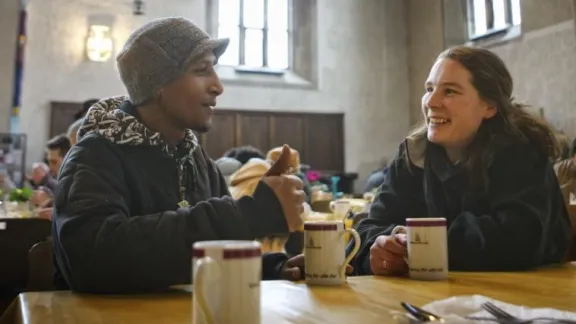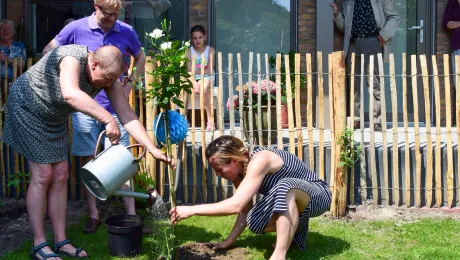Diakonia has always borrowed terms from the surrounding culture and discourse, just as has theology. When The Lutheran World Federation (LWF) European Solidarity Group and LWF’s partner International Academy for Diaconia and Social Action (interdiac) were exploring how to express the core meaning of diakonia in relation to today’s challenges, a key concern was response to the question: How can we live together?. This included not only interpersonal relationships across diverse people and contexts, it also raised the question about structures and political positions that make it difficult to live together in peace with justice. Not of course forgetting the pressing environmental challenges.
The answer the European Solidarity Group came up with was formulated as, “Diakonia, Seeking Conviviality, the art and practice of living together.” To include the word practice seems straightforward: it implies not only the practice of everyday life but also the professional practice of people and organizations doing diaconal work and especially the life of the diaconal church. But why ‘conviviality’?
The Latin root for conviviality (con-viver) simply means living together! In the noun form—convivium—it refers more specifically to common life around the table. This immediately brings to mind the fact that the central act of Christian worship – the Eucharist – is also about sharing food and how food is shared around a table.
In our thinking we have been inspired by a number of different streams of thought. The first is that in Spanish history there was a period when it seems that Christians, Jews and Muslims were able to live together in relative peace. This period before Christianization is known as ‘la convivencia’. The next impulse comes from nineteenth century Parisian culture of people meeting together over a meal and maybe a glass of wine to discuss the issues of the day. In such a discussion everyone was able to make their contribution and have it discussed. Nothing was ruled out. Of course, these tables were rather exclusive, but still there is resonance with the Latin root of the word and looking it up in a dictionary, this informs the present everyday meaning of the word.
The third inspiration comes from Ivan Illich, a Croatian-Austrian with Jewish and Catholic parents, who became priest of an immigrant parish in New York, then moved to Puerto Rico where he founded a training and research institute. The aim was to train people from the global north going to work in Latin America to work with sensitivity and not to impose their values. He used the word conviviality to mean the autonomous and creative relationship between people: people and their environment and people and technology. He considered conviviality to be the freedom realized in personal interdependence and, as such, an intrinsic ethical value and his fundamental theological motif was ‘incarnation’. The fourth inspiring reflection comes from Paul Gilroy who contrasted the everyday conviviality among migrant diaspora communities with the melancholia of the post-colonial white communities.
In the European Solidarity Group, we took this phrase as a way to interpret the context and to characterize diaconal action. In the first phase of our work we linked conviviality to the core concepts of vocation, dignity and justice out of which we developed some guidelines for practice. In the second phase we looked at work and economy, taking a convivial perspective and in the most recent phase, the group has been working on conviviality and the borders that run between us and through us, personally, professionally and as churches. As we see in the present context, the rapid changes and the mixing of people from different backgrounds means that people’s identities are not fixed. It also means that church communities have to reflect on their own identity, whether they see themselves traditionally in majority or minority situations.
With its basis on respect, relationships and reciprocity, conviviality is very important in reflecting on living in diverse and diversifying societies and in developing appropriate practice. These characteristics open the church and diakonia to the many diverse ‘life-worlds’ for shared life together on the basis of trust and dialogue.

Vesperkirche. Photo: Gottfried Stoppel
Since we started our work, it seems that in many disciplines and many forms of practice, conviviality is becoming an important term, although it is used in different ways. Most importantly it has been used to reflect on diversity that results from people being on the move, but it has also been used to shift the understanding of planning, thus becoming the core concept of a movement for reformulating the dominant economic model. In addition, certain theological streams have now started to use the word, the notable pioneer being Theo Sundermeier who used it to argue for a paradigm shift in mission around the same time as Illich was writing. It also creates a space for rethinking personal and professional social practice and diaconal work and planning. Below, we will relate conviviality to different arenas where it is being used at the moment, starting with theology.
In theology, if we take an incarnational approach to being with the different ‘other’ the possibility to learn from each other is opened up. This demands the trust to expose your own identity, then it is possible to build mutual relationships with people who are different from us. It increasingly important in a diversifying world.
When people are moving around and settling in new areas they naturally need to be treated hospitably. This is the biblical way. But when people are going to stay for a longer period, it is important to change our view because hospitality is related to guests who are just visiting us. Conviviality offers tools to live together in solidarity.
The concept of conviviality also draws attention to the fact that all communities are diverse. It means that the art and practice of living together demands a conscious approach to learning together and having dialogue with each other for promoting change. Changes may appear in culture, society, policies, world view or understanding of faith and religious practice or spirituality. Through the process of building conviviality, people build trust and reciprocity and can join together in creative work for a better future.
In the work of the Solidarity Group we have explored many theological themes in relation to conviviality and diaconal practice, which can be found in the ‘Resources’ section of this web site.
Kontact
Get Involved
Share with us your stories, photographs and insights using the #LWF




In social sciences, conviviality handles and analyzes the reality of everyday living in the context of diversity. Conviviality starts without fixed presuppositions of identity and it considers people through their actual interrelatedness and the meanings they give to these interactions themselves. It has been used as an analytical concept for instance in the research of everyday life in diverse suburbs.
It is said that the built environment and the physical space shape the possibilities for convivial encounters. There are always (physical) borders and fences between people, which should be overcome. The different ‘other’ remains different unless there are possibilities to meet and learn from each other. Trust, comfort, amenity and a safe space encourage encounters. In each context there are particular people who connect and bridge between people. In encountering each other people get to develop mutual reciprocity where all are givers and receivers. The importance of an intercultural habitus, which is related to a disposition for local encounters, is also meaningful. Habitus includes the disposition of people and the tacit knowledge with which they approach any situation. Through everyday interaction people learn to blur boundaries and identities, to negotiate with each other and accommodate different practices. These aspects can support convivial life together.